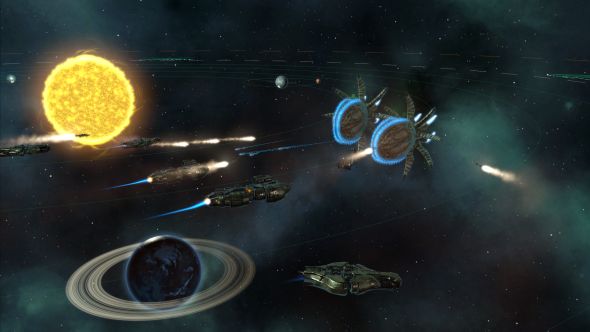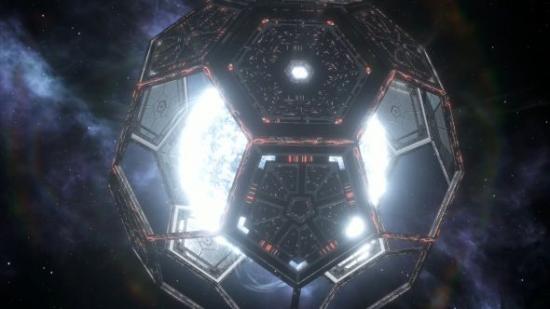At GDC this March, PCGamesN spoke with Martin Anward, game director of epic space strategy game Stellaris. That game’s first major expansion, Utopia, has finally got a release date: April 6. Anward filled us in on what we can expect, both from Utopia itself and the free ‘Banks’ update that will coincide with it.
Feeling like clicking on things and having those clicks affect millions of lives? Try the PC’s best strategy games, you megalomaniac.
“The focus of the expansion is empire customisation and development,” says Anward, “adding more playstyles, and basically letting players build their own idea of Utopia.”
A Utopia that the Stellaris community itself has been shaping since release with its feedback to Paradox. In many ways this expansion is designed by players themselves. “There is definitely a big element of that,” says Anward. “I wrote a dev diary about this some time ago – it was called The Journey Ahead. Some of these are maybe things we thought about before, but didn’t have a clear vision of. And a lot of it was definitely feedback from the players. One thing we heard is, ‘There aren’t enough ways to play the game. There is only conquering, you can only expand. If you don’t expand, you’re limiting yourself.’ So that is definitely to a large degree the result of feedback from players – adding more ways to play, adding the ability to play as an actual pacifist. Build tall, so to speak.”
In responding to player feedback, Anward and Paradox realised Stellaris is as much about the way people role-play their species as anything else. “ I’d almost call it like a role-playing grand strategy hybrid. That is definitely another thing that we have been working hard to reinforce, based on how players have been receiving the game.”
The upcoming expansion has a lot of ground to cover and boxes to tick, then. Here’s how the new content breaks down.
Habitats

“One of the things we’re focusing on with Utopia is adding more things to do within your space,” says Anward. In strategy parlance, “more ways to build tall.”
Habitats are one of the headline features that allow this. Essentially, they’re massive space stations, designed to house more citizens for your empire. If you find yourself hemmed in, unable to expand without war, habitats are a way to grow your population without getting all colonial about it.
“They function like planets,” says Anward. “You populate them, and they have their own unique set of buildings that you can only build on habitats. They are very good at energy and science production. Not so great at food and mineral production, since, you know – you don’t really have any natural resources.”
Habitats need to be built in orbit around planets, so if you have a system with a lot of planets, you can squeeze in a lot of habitats. They’re also a neat way around another current limitation on building tall in Stellaris, and that’s naval capacity, which is based on the planets you have. Habitats will give a fixed, large boost to naval capacity, so they’re a route to good energy production and large fleets. This will help peaceful builder types defend themselves against expansionist conquerors.
Megastructures

“Megastructures are kind of the signature feature of Utopia”, says Anward. There are four of them: Ring Worlds, Science Nexuses, Sentry Arrays and Dyson Spheres. Ring Worlds are already in the game, but can now be built, and are essentially massive habitats, with room for loads of pops. The Science Nexus is a huge orbital research station, that will give increasing quantities of science during its construction. When it’s finished, you can copy the minds of scientists into it to make it more efficient.
The Sentry Array provides intelligence. As you build it, its sensor range grows, and when it’s complete you’ll be able to see everything that’s going on in the galaxy. Finally, the Dyson Sphere is the biggest and most ambitious megastructure of them all. “Even compared to the others,” says Anward, “it takes a ludicrous amount of resources and time to build. But it also gives ridiculous benefits.”
The Dyson Sphere is what we’ve seen in the Utopia reveal trailer: a massive construction encircling a star, gradually upgraded with solar panels. A finished one can provide as much as 400 a month, but like the other megastructures, Dyson Spheres will deliver their benefits incrementally during their construction, rather than all at once when they’re done.
Though they’re expensive and provide great benefits, Megastructures differ somewhat from Wonders in other strategy games. You can have several copies of each, even within the same faction – the only limitation is that you can only be working on one at a time. There’s still a bit of ceremony attached to them – you’ll see them take shape on the galaxy with construction animations, and get narrated event updates as they’re built, even if they’re built by rivals. You can then react to that intelligence.
Traditions and Ascension

Utopia is also looking to deepen Stellaris’s role-playing elements, adding more flavour to the kind of society you’re building. A new resource, Unity, is introduced, which will allow you to purchase new traditions. Anward says these are “like social policies in Civ V, or ideas in Europa Universalis IV.” As in those games, traditions are grouped into trees that represent your society’s goals and ideals – if you decide you want to be diplomats, you’ll pursue the corresponding tree. Likewise with science, exploration, and so on.
Traditions are in the free Banks update, but when you finish a tree, you gain what’s called an Ascension perk. These are part of the paid expansion, Utopia, and they specialise your empire in a variety of ways.
“For example, you actually need an Ascension park to be able to build habitats,” says Anward, who also says by opting for one perk, “you are giving up some other kind of benefit which may be better for a more expansionistic empire.” Whether this is because perks simply take a lot of effort to unlock or directly conflict with each other isn’t clear. Megastructures are also locked behind this feature.
And then there are the ascension paths, of which there are three: the Biological path, the Psionic path, and the Synthetic path. These are end-game goals that represent your vision of who you want to become as a species.
“Each path comes with two steps,” says Anward. “The biological ascension path lets you become a master of gene modding. You can learn to mod species in new ways, and when you complete it you will get access to a bunch of traits and abilities that nobody else has. You will be able to reach into DNA at will, rework species according to the way you want them.
“The Psionic path awakens the psionic potential of your species. At the first step, they become latent telepaths and will gain a variety of benefits. You can recruit psionic armies, you can build special buildings, your population are more efficient in certain things. And as you advance all the way down, your species will awaken – everyone will basically become a telepath, and you will also be able to enter what’s called the Shroud, an alternative dimension where psionics come from and ascended beings live. You will actually be able to speak with some of those beings and potentially sign deals with them.”We heard a little about this in a recent dev diary.
“In the Synthetic Ascension path, you decide that biology just doesn’t cut it. It’s time to bring in the machines. When you unlock the first step, which requires a decent understanding of robotics, you will get a special project. This will take a certain amount of time to complete depending on your research and how big your population is. And what this project does is that it converts people into cyborgs. You start replacing biology with machine.
“When complete, we are no longer humans, we are superhumans. We are cybernetic, giving a variety of benefits, such as the ability to live on planets that would otherwise not be habitable for us. Better mineral production, better fighters. And our leaders will also be cyborgs and live for longer, since they can replace their parts with machines.”
After mastering robotics and AI, the final step on the synthetic path is synthetic evolution. “you essentially replace all the biology, not just some of the biology. Once it is complete, there are no more humans. There is no more flesh. And you will be given the ability to name your robot species once you are complete – you can call it pretty much whatever you want. All of your dudes are now very efficient machines, they are good at basically everything. Your leaders are basically immortal, they can only die in battle, they can never die from old age.
“However, the downside is that other empires will typically not be that trustful of robots. Especially spiritualists, who will be like, ‘You guys got rid of your souls!’”
Both steps on each ascension path will have different requirements, and the first can come relatively early on. “You don’t have to wait the entire game to have cyborgs – you get them at maybe 60, 80 years in. And then you take the full move to robots later.”
Of course, if you’d rather not mod your DNA or replace it with synthetic stuff, you don’t have to pursue any ascension path.
Governments and civics

A more conventional form of social engineering is also possible, as the Banks update will add the ability to customise your government.
First up, you’ll choose an Authority. “Do you want power to be transferred democratically, is it dictatorial, do you have an emperor with an heir?” says Anward. Then you’ll choose some civics, which determine the make-up of your government. “Do you have a parliamentary system along with your democracy? Do you focus on functional architecture? And so on.” From that, Stellaris derives your government’s title.
Utopia will expand on this a bit, with some advanced Civics. One example Anward gives is Synthetic Evolution, which lets you start with a second species on your own planet. “On Earth, you will have the Neoships – this species are a little dumber, a little stronger, dimmer, good workers. Depending on your ethics, how you work with them could be very different. They could be slaves, they could be equals.”
In a similar vein is the Mechanist, which allows you an advance on robots from the start and lets you fast-track down the synthetic path. “And we have the Fanatic Purifiers,” says Anward, “which are kind of special. It’s you basically deciding that your species is the only one that’s allowed to exist. If you pick this one, you will disable all diplomacy in the game. The only thing you can do is declare war, declare rivalry and send insults. It also disables a lot of special interactions between things like independent space stations, where normally you would be able to call them up and say, ‘Hey, let’s trade’. You will only be able to call them up to yell insults over the communicator.”
But it does give you some very significant benefits – you get a huge bonus to your combat abilities, and in addition gain Unity, which is the resource for Traditions and Ascension perks, by purging. That means you can develop your empire and your species by wiping out other species. But the downside is that everyone will hate you.
Utopia will also expand the Ethos system with some new ethics – Anward talks enthusiastically about the Hivemind ethic, which can’t be combined with any other, forces you to pick a specific authority, and has its own exclusive civics. “Essentially there’s no individual will among your pops,” says Anward. “Previously they would have happiness, and an ethic, and they might be part of a faction. You get none of that – there is no happiness, everyone is just a drone working for the collective, moving in the same direction.
“You have no internal political strife, but you also don’t get the same benefits of factions that support you. Factions in the Banks update will be able to support you, they will be able to do things. And you also can’t rule other pops from non-Hiveminded species. If non-Hiveminded pops end up inside your empire they will be treated like a virus, an infection, and your drones will attack them, kill them and process them into food for the collective.”
Anward is clear that “the vast majority” of the new ethics and civics are free in Banks. It’s only the “special” civics, with far-reaching implications for your species, that are part of the expansion – Anward names them as Synthetic Evolution, the Mechanist, Synthetic Purifiers and the Hivemind. “We’re trying to keep these large gameplay systems free for everyone, like government, but we add these extra things. So you get the big stuff for free, and then you pay for the extra content, the cool stuff.”
Indoctrination

If you have a megalomaniacal streak – and it’s just a personal theory that many strategy gamers do – you’ll be happy to know there’s a new way to mess with pre-FTL, or ‘primitive’ civilisations.
Currently, you can conquer or uplift primitives, but if you opt for the latter, their particular ethics can disrupt those of your own empire.
If the word ‘purge’ makes you feel a little queasy, Utopia adds a new solution, albeit one with an only slightly less horrifying name: indoctrination.
“You start influencing their culture and religion,” says Anward, “to make them come around to your way of thinking.” You could invent a new religion that just happens to share your own cultural tenets, and “beam down a holographic god” to tell the primitives what to think.
Over time, this will convert the pops on a given planet to a new set of ethics. “You’ll have events telling you the outpost has changed, and if you let it run long enough they will be ready for enlightenment, annexation, whatever it is you want to do,” says Anward.
It sounds like there’s a way for affected pops to figure out what you’re up to, though, as Anward warns of consequences – “especially if they have nukes”, he adds, in a rather chilling conclusion.
Utopia will be available on April 6. Will you be building a better future with it? Let us know below.
